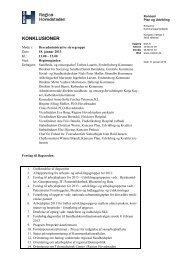Territorial Review Copenhagen - Region Hovedstaden
Territorial Review Copenhagen - Region Hovedstaden
Territorial Review Copenhagen - Region Hovedstaden
You also want an ePaper? Increase the reach of your titles
YUMPU automatically turns print PDFs into web optimized ePapers that Google loves.
131<br />
Box 2.2. <strong>Copenhagen</strong> Model for Integration: Immigrants and the<br />
schooling system<br />
The aim of the <strong>Copenhagen</strong> Model for Integration is to create a more even<br />
distribution of bilingual students across <strong>Copenhagen</strong> schools. The programme<br />
followed two surveys regarding the position of parents of bilingual children,<br />
which showed that immigrant parents had positive attitudes towards enrolling<br />
their children in schools with only a small percentage of immigrant children,<br />
whereas native Danish parents were hesitant about enrolment of their children in<br />
schools that were dominated by immigrant children. The programme contains<br />
two main elements. First, it offers immigrant students from certain school<br />
districts the possibility of enrolment in schools with predominantly native<br />
Danish students. Second, it aims to make schools with a high percentage of<br />
immigrant students more attractive to native Danish parents and students. The<br />
<strong>Copenhagen</strong> Model for Integration is carried out by the Children and Youth<br />
Administration of the City of <strong>Copenhagen</strong>.<br />
The programme started in 2006, when 85 immigrant children from districts<br />
with large concentrations of ethnic minorities (Tingbjerg, Voldparken, Indre<br />
Nørrebro) began their schooling in districts where only a small percentage of the<br />
students are immigrants (Brønshøj-Husum, Østerbro). The programme has been<br />
extended since, and other districts are now included. From the school year<br />
2008/2009, 13 schools in Østerbro, Vanløse, Brønshøj, Nørrebro and Amager<br />
will be part of the initiative to reserve seats for bilingual students from other<br />
districts. Ten schools in Valby, Nord Vest and Amager are involved in the<br />
initiative to keep native Danish children in schools with a large share of<br />
immigrants. (Source: www.tosprogede.kk.dk). Since 2004, there has been an<br />
increase of 185 bilingual pupils in kindergarten and first grade. At the ten<br />
schools mentioned, the total share of bilingual pupils has risen from 494 to<br />
1 102, an increase of 608 bilingual pupils.<br />
Lackluster scores on the OECD/PISA Study in 2000 and 2004 initiated<br />
an OECD <strong>Review</strong> of Compulsory Education recommending that student<br />
assessment be enhanced, school management strengthened and teacher<br />
training become more specialised (OECD, 2004). It was determined that<br />
more frequent systematic evaluation of student achievement would help to<br />
identify learning problems at an early stage, and that encouraging teachers to<br />
specialise would help raise their professional competences and benefit<br />
subjects like science. In spring 2008, an agreement was reached between<br />
City of <strong>Copenhagen</strong>, the University of <strong>Copenhagen</strong> and University Colleges<br />
Denmark in the Capital <strong>Region</strong> about the creation of three special flagship<br />
schools for <strong>Copenhagen</strong>. On 1 August, 2009, on a DKK 3.5 million budget,<br />
the three special schools will open, including a language school, natural<br />
science school and a musical-creative school staffed by specialists, with the

















